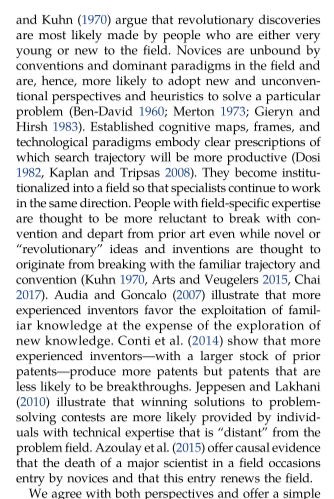joelchan's working notes
Powered by 🌱Roam GardenJuly 27th, 2021
This is an "Orphan" page. Its core content has not been shared: what you see below is a loose collection of pages and page snippets that mention this page, as well as snippets of this page that were quoted elsewhere.
@kneelandExploringUnchartedTerritory2020 for [[QUE - How might domain distance modulate the effects of analogies on creative output?]] | teams with broader prior patent experience more likely to generate outlier patents; examples of long search paths and distant recombination leading to outlier patents
basically sampled people to talk to based on "outlier" outputs (quant), and then talked to them and did qual analysis to identify themes of how they came up with their inventions. that's the first part anyway.
this is more of an informal theory-building (in the m/Grounded Theory lite sense) than empirical findings per se, i think. and it says nothing about the extent to which these are the only or most important mechanisms for generating outlier innovations.
most interesting for us i think is the idea of long search paths, which they describe as an innovation that looks like a very large leap from previous ideas, but is actually composed of a lot of small(er) improvements that combine over time, and are known only to the inventor
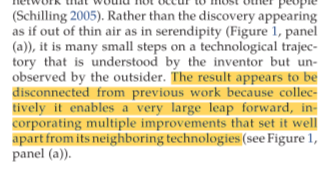 (p. 540)
(p. 540)
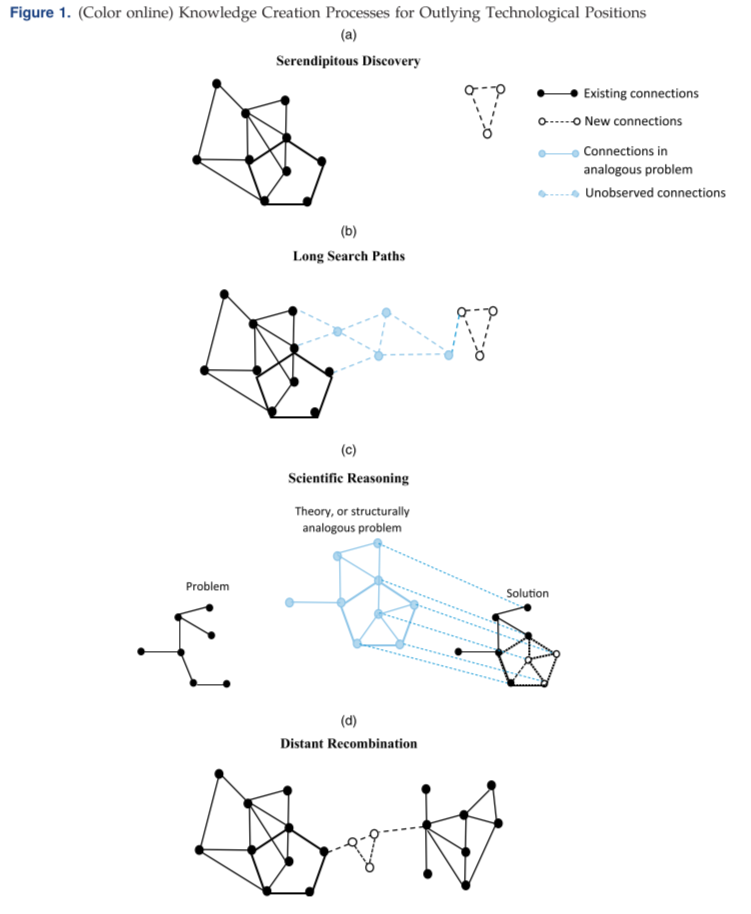 (p. 540)
(p. 540)
may involve scientific reasoning, but not necessarily
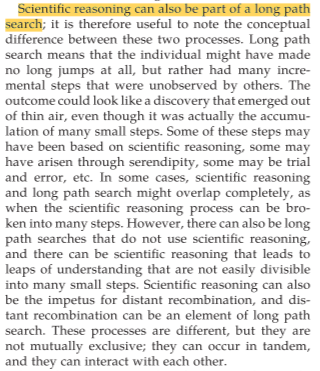 (p. 544)
(p. 544)
also interesting is the idea of distant recombination, which feels like a mix of far conceptual combination and far analogies and outsider innovation, depending on the examples. don't find this to be particularly well theorized. but this connects very well to the way @uzziAtypicalCombinationsScientific2013 and @wangBiasNoveltyScience2017 think about things
two stories illustrate the idea of long search paths
spider-silk lactating goats!
from 1993 to first breakthrough in funding and patenting in like... 2013 or 2015
relevant tabs
BioSteel - Wikipedia: https://en.wikipedia.org/wiki/BioSteel
Scientists breed goats that produce spider silk: https://phys.org/news/2010-05-scientists-goats-spider-silk.html
What happened to those GM spider goats with the silky milk? - AFN: https://agfundernews.com/what-happened-to-those-gm-spider-goats-with-the-silky-milk.html
costas karatzas spider silk - Google Search: https://www.google.com/search?q=costas+karatzas+spider+silk&sxsrf=ALeKk00Q1bDZJfa4TuIUoUSRt3tvmmEeWA%3A1626969038133&ei=zpP5YO62B5Sz5NoPnaaCyAM&oq=costas+karatzas+spider+silk&gs_lcp=Cgdnd3Mtd2l6EAMyBQghEKsCOgUIABCwAzoHCAAQsAMQHjoGCAAQFhAeOgUIIRCgAToHCCEQChCgAUoECEEYAVD5O1jiS2DGTWgBcAB4AIABX4gBngeSAQIxM5gBAKABAaoBB2d3cy13aXrIAQLAAQE&sclient=gws-wiz&ved=0ahUKEwju1c_8g_fxAhWUGVkFHR2TADkQ4dUDCA4&uact=5
Costas Karatzas Inventions, Patents and Patent Applications - Justia Patents Search: https://patents.justia.com/inventor/costas-karatzas
funcitonal flow cytometry (basically a new way to do super-specific and super-sensitive detection of radioactivity)
60+ years!
this really reminds me of dunbar's claim about [[CLM - far analogies are systematically overrated in their importance for creative breakthroughs due to memory bias - @dunbarHowScientistsThink1997]]
and [[EVD - A molecular biologist who had made a major scientific conceptual change did not recall any of the spontaneous analogies used to enact that change - @dunbarHowScientistsThink1997]]
second part of the paper is empirical quant analysis though, relating inventor (team) characteristics to p(outlier) in terms of novelty/distance from similar patents (so basically super novel above some threshold of quality?).
methods notes
definition of outliers: patents that, at the time of filing, were at least two steps away from all preexisting patents in terms of the USPTO mainline subclasses. used this technique to classify ~1.5M patents filed between 1990 and 2000, of which ~120k (~8%) were outlier patents by this definition.
 (p. 537)
(p. 537)
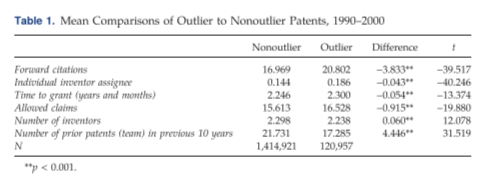
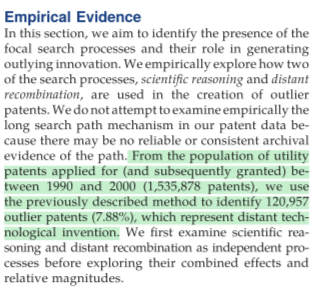 (p. 546)
(p. 546)
definition of distant recombination: essentially the number of unique fields (per NBER 38 industry classifications) the inventor(s) (solo or team) had successfully patented within 10 years += year of application. collective breadth is total number of fields in the team, and max breadth is largest per-inventor count of fields.
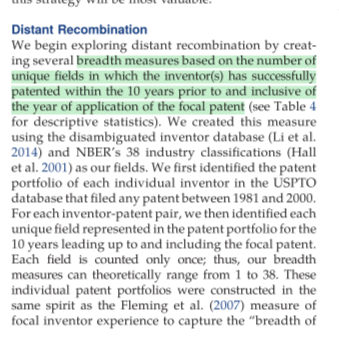 (p. 548)
(p. 548)
 (p. 548)
(p. 548)
 (p. 548)
(p. 548)
estimation: logit (linear?) regression
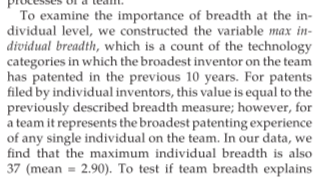 (p. 547)
(p. 547)
most interesting result for us is the breadth of inventor backgrounds and patenting experience
- for inventor breadth of fields (additive effects on top of that for team breadth): [[EVD - patenting teams with a greater number of prior patenting fields were more likely to generate patents that were technological outliers - @kneelandExploringUnchartedTerritory2020]]
- for patenting experience
discussion
distant recombination measure makes me a bit grumpy: it's a diversity measure rather than a distance measure (which is how it's theorized)
@artsParadiseNoveltyLoss2018a for [[QUE - How might domain distance modulate the effects of analogies on creative output?]] | if inventor files a patent in a new field they haven't explored before, their patent tends to be more novel; there's also a citation penalty, but this gets canceled out if they collaborate with an expert in the new field
correlation + natural experiment from unintended change in noncompete labor law
exploring new fields ++ novelty but --value (proxied with raw citations)
per @wangBiasNoveltyScience2017 be super careful about this outcome measure of value given [long vs. short run differences for highly novel stuff]([[EVD - highly novel papers were more likely to be in the top 1% of citations in the long run, but not in the short run, and particularly in other fields - @wangBiasNoveltyScience2017]])
the relevance for our question here is that inventors who explore a new field (to the extent that it is different from their own) and then later go on to invent new things that are better are at least possibly (we don't know for sure) doing a form of far analogies or conceptual combination: tough to distinguish.
i really want to watch out for whether they make any attempt to trace actual relationships between the things cited and the things proposed, *conceptually* (in content terms)
what did they do?
study 1: correlational study
sample: ~400k inventors of ~2.7M patents, across ~47k firms
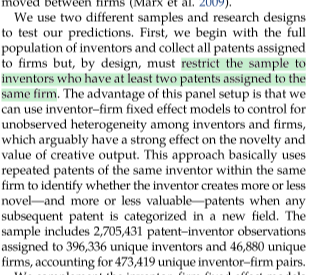
estimation strategy: inventor-firm fixed effects panel models
dependent measure: novelty = number of pairwise subclass combinations in the focal patent that appear for the first time in the patent database
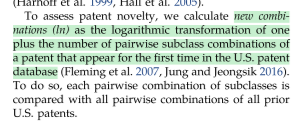 (p. 5)
(p. 5)
similar to @wangBiasNoveltyScience2017
dependent measure: "value" = number of forward citations in the 10 years after the patent is approved
 (p. 5)
(p. 5)
independent variable: exploring new fields = 0 or 1 (if focal patent has no overlapping classes with all prior patents from the same inventor)
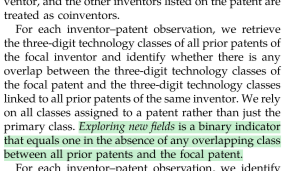
independent variable: expert team = 1 if at least one co-inventor has prior patent with same class as focal patent (else 0)

study 2: natural experiment with michigan antitrust reform act
context: Michigan Antitrust Reform Act (MARA)
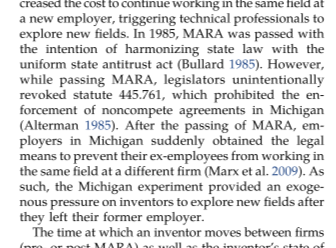 (p. 11)
(p. 11)
sample: ~29k inventors of ~162k patents in michigan vs. not-michigan who filed patents after moving firms within the same state between 1975 and 1995 (+/- 10 yrs of MARA law passing)
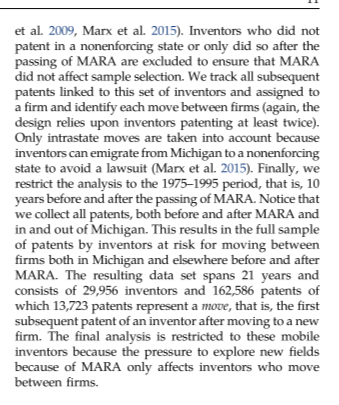 (p. 11)
(p. 11)
estimation strategy: difference in difference analysis
what did they find?
[[EVD - patents filed by inventors who was new to the patent's field tended to be more novel; this was less true if they collaborated with an expert in the new field - @artsParadiseNoveltyLoss2018a]]
[[EVD - patents filed by inventors who was new to the patent's field tended to receive slightly fewer citations, except when they collaborated with an expert in the new field - @artsParadiseNoveltyLoss2018a]]
there's also a result here that is similar to what @kneelandExploringUnchartedTerritory2020 finds re: science citations: positive effect of citing nonpatent prior art (mostly science pubs)
what might this mean?
the results about expert collaborations in new fields reversing negative effects on forward citations (without canceling out novelty advantage) is really interesting and relevant for [[QUE - What are the most efficient routes to useful cross-boundary knowledge?]]
side notes
➰ breadcrumbs more citations for the outsider innovation effect, leaning a bit more on the "useful naivete" mechanism rather than "transferring in new things" piece
